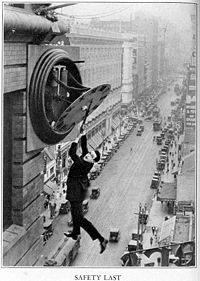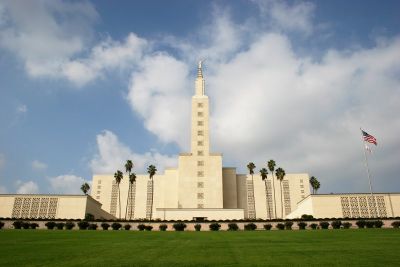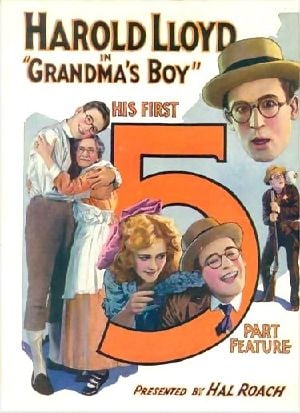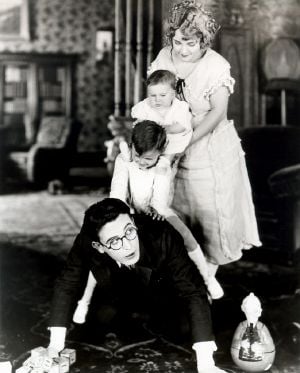Harold Lloyd
| Harold Lloyd | |
|---|---|
 Harold Lloyd in "Safety Last" | |
| Birth name | Harold Clayton Lloyd |
| Born | April 20 1893 Burchard, Nebraska |
| Died | March 8 1971 (aged 77) Beverly Hills, California |
| Medium | motion pictures (silent and sound) |
| Nationality | American |
| Years active | 1913-1950 |
| Genres | slapstick, comedic thrillers |
| Influences | Charlie Chaplin |
| Influenced | Buster Keaton |
| Spouse | Mildred Davis (m. Feb. 10, 1923 - Aug 18, 1969; her death) |
| Notable works and roles | Safety Last (1923) The Freshman (1925) The Kid Brother (1927) |
| Academy Awards | |
| 1953 Lifetime Achievement | |
Harold Clayton Lloyd, Sr. (April 20, 1893 - March 8, 1971) was an American film actor and producer, most famous for his silent film comedies. He made nearly 200 comedy films, both silent and "talkies," between 1914 and 1947. He is best known for his "Glasses Character," a resourceful, success-seeking go-getter who was perfectly in tune with 1920s-era America.
Lloyd's films frequently contained thrill sequences of extended chase scenes and daredevil physical feats, for which he is best remembered today. Lloyd hanging from the hands of a clock high above a busy street in Safety Last! is one of the most enduring images in all of cinema.
Although Lloyd's individual films were not as commercially successful as Charlie Chaplin's on average, he was far more prolific, releasing 12 feature films in the 1920s while Chaplin released just three. He was also a highly successful producer and became one of the wealthiest man in Hollywood. He made a semi-successful transition to the era of the "talkies" but was unable to sustain his character's comic appeal during the Great Depression. He devoted himself to charity work and photography during his retirement, experiencing a wave of new interest in his work in the 1960s.
Lloyd ranks alongside Charlie Chaplin and Buster Keaton as one of the most popular and influential film comedians and producers of the silent-film era.
Biography
Harold Lloyd was born on April 20, 1893 in Burchard, Nebraska, to James Darsie Lloyd and Elizabeth Fraser; his paternal great-grandparents were from Wales. In 1912, his father was awarded the then-massive sum of $6,000 in a personal-injury judgment and the family moved to southern California.
Lloyd married his leading lady, Mildred Davis, on February 10, 1923. Together, they had two children: Gloria Lloyd (born 1923), and Harold Clayton Lloyd, Jr., (1931-1971). They also adopted another child, Gloria Freeman (1924-1986), in September 1930. They renamed her Marjorie Elizabeth Lloyd, but she was known as "Peggy" for most of her life.
After their marriage, Lloyd initially discouraged Davis from continuing her acting career. He later relented, but by that time her career momentum was lost. Harold Jr. was gay, and several commentators have noted that Lloyd took the news of his son's homosexuality in a remarkably accepting way for the time.
Davis died in 1969, two years before her husband.
Harold Lloyd died at age 77 from prostate cancer on March 8, 1971, in Beverly Hills, California. He was interred in a crypt in the Great Mausoleum at Forest Lawn Memorial Park Cemetery in Glendale, California.
Silent films
Harold had acted in theater since his boyhood and started acting in one-reel film comedies shortly after moving to California. He soon began working with Thomas Edison's motion picture company and eventually formed a partnership with fellow struggling actor and director Hal Roach, who had formed his own studio in 1913. The hard-working Lloyd became the most successful of Roach's comic actors between 1915 and 1919.
Lloyd hired Bebe Daniels as a supporting actress in 1914. The two of them became involved romantically and were known as "The Boy" and "The Girl." Lloyd's early film characters, such as "Lonesome Luke," were by his own admission a frenetic imitation of Charlie Chaplin. From 1915 to 1917, Lloyd and Roach created more than 60 one-reeler comedies in the spirit of Chaplin's early comedies.
By 1918, Lloyd had begun to develop his character beyond an imitation of his contemporaries. He moved away from tragicomic personae to portray an everyman with unwavering confidence and optimism. The "Glasses Character" (always named "Harold" in the silent films) was a more mature comedy character with greater potential for sympathy and emotional depth, and was easy for audiences of the time to identify with. The Glasses Character is said to have been created after Roach suggested that Harold was too handsome to do comedy without some sort of disguise. Previously, Lloyd had worn a fake mustache as the Chaplinesque "Lonesome Luke."
Unlike most silent comedy personas, "Harold" was never typecast to a social class, but he was always striving for success and recognition. Within the first few years of the character's debut, he had portrayed social ranks ranging from a starving vagrant in From Hand to Mouth to a wealthy socialite in Captain Kidd's Kids.
Lloyd's films often featured thrilling chase scenes and death-defying stunts, many of which Lloyd performed himself. In 1919 he injured himself during the filming of Haunted Spooks when an accident with a prop bomb resulted in the loss of the thumb and index finger of his right hand. Lloyd continued doing stunt work despite the injury, which was disguised on film with the use of a special prosthetic glove.
In 1919, after Daniels left Lloyd because of greater dramatic aspirations, he replaced her with Mildred Davis. Beginning in 1921, Roach and Lloyd moved from shorts to feature length comedies. These included the acclaimed Grandma's Boy, Why Worry? and the sensational Safety Last! which cemented Lloyd's stardom with its classic scene of Lloyd hanging from the hands of a huge clock over a busy street.
In 1924, Lloyd formed his own independent film production company, the Harold Lloyd Film Corporation, with his films distributed by Pathé and later Paramount and Twentieth Century-Fox. He was also a founding member of the Academy of Motion Picture Arts and Sciences. Lloyd's films during this period included his most accomplished mature features Girl Shy, The Freshman, The Kid Brother, and Speedy, his final silent film. All of these films were enormously successful and profitable and helped Lloyd become the highest-paid film performer of the 1920s. From this success he became one of the wealthiest and most influential figures in early Hollywood.
Transition to "talkies"
Lloyd made the transition to sound in 1929 with Welcome Danger. Released a few weeks before the start of the Great Depression, it was a huge financial success, with audiences eager to hear Lloyd's voice on film. However, the rate of his film releases, which had been one or two a year in the 1920s, slowed to about one every two years until 1938.
The films released during this period were: Feet First, with a similar scenario to Safety Last; Movie Crazy with Constance Cummings; The Cat's-Paw, a dark political comedy and a big departure for Lloyd; and The Milky Way, which was Lloyd's only attempt at the then-fashionable genre of the screwball comedy.

Unfortunately, Lloyd's go-getting screen character was now out of touch with Great Depression movie audiences of the 1930s. As the length of time between his film releases increased, his popularity declined, as did the fortunes of his production company. His final film of the decade, Professor Beware, was made by the Paramount staff, with Lloyd functioning only as actor and partial financier. On March 23, 1937, Lloyd sold the land of his studio to the Church of Jesus Christ of Latter-Day Saints. The location is now the site of the famous Mormon Los Angeles California Temple on Santa Monica Boulevard in the Westwood district.
Lloyd produced several comedies for RKO Radio Pictures in the early 1940s, but otherwise retired from the screen until 1947. He then returned for a starring appearance in The Sin of Harold Diddlebock, an ill-fated homage to Lloyd's career directed by Preston Sturges and financed by Howard Hughes. Hughes issued a recut version of the film in 1951 through RKO under the title Mad Wednesday. Such was Lloyd's disdain for the film that he sued Hughes and RKO for damages to his reputation "as an outstanding motion picture star and personality," eventually accepting a $30,000 settlement.
Radio and retirement
In October 1944, Lloyd emerged as the director and host of The Old Gold Comedy Theater, an NBC radio-anthology series, after Preston Sturges, who had turned the job down, recommended him for it. The show presented half-hour radio adaptations of recently successful film comedies, beginning with Palm Beach Story with Claudette Colbert and Robert Young.
The Old Gold Comedy Theater featured some of the best-known film and radio personalities of the day, including Fred Allen, June Allyson, Lucille Ball, Ralph Bellamy, Linda Darnell, Susan Hayward, Herbert Marshall, Dick Powell, Edward G. Robinson, Jane Wyman, and Alan Young, among others. However, the show was not a great success, and lasted only one year.
Lloyd remained involved in a number of other interests, including civic and charity work. Inspired by having overcome his own serious injuries and burns, he was very active with the Shriners Hospital for Crippled Children, and eventually rose to that organization's highest office.
Lloyd studied colors, microscopy, and was very involved with photography, including 3D photography and color film experiments. He became known for his nude photographs of models, such as Bettie Page and stripper Dixie Evans, for a number of men's magazines. He also took photos of Marilyn Monroe lounging at his pool in a bathing suit, which were published after their deaths.
Lloyd appeared as himself on several television shows during his retirement, including Ed Sullivan's variety show Toast of the Town, What's My Line? and This Is Your Life. He also provided encouragement and support for a number of younger actors, such as Debbie Reynolds, Robert Wagner, and particularly Jack Lemmon, whom Harold declared as his own choice to play him in a movie of his life and work.
Lloyd kept copyright control of most of his films and re-released them infrequently after his retirement. As a consequence, his reputation and public recognition suffered in comparison with Chaplin and Keaton, whose work has generally been more available.
In the early 1960s, Lloyd produced two compilation films, featuring scenes from his old comedies, Harold Lloyd's World of Comedy and The Funny Side of Life. The first film was premiered at the 1962 Cannes Film Festival, where Lloyd was feted as a major rediscovery. The renewed interest in Lloyd helped restore his status among film historians. Throughout his later years he screened his films to great acclaim at special charity and educational events and found a particularly receptive audience among college audiences.
Legacy
Lloyd's films were highly influential and still find many fans among modern audiences, a testament to the originality and film-making skill of Lloyd and his collaborators. His was only the fourth ceremony preserving his handprints, footprints, and autograph at Grauman's Chinese Theatre in 1927. Lloyd was honored in 1960 for his contribution to motion pictures with a star located at 1503 Vine Street on the Hollywood Walk of Fame. In 1994, he was honored with his image on a United States postage stamp designed by caricaturist Al Hirschfeld. The University of Southern California School of Cinematic Arts features the Harold Lloyd Sound Stage; Lloyd was a donor to the film school.
In 1953, Lloyd received a special Academy Award for being a "master comedian and good citizen." The second citation was a snub to Charlie Chaplin, who had fallen foul of McCarthyism and had his entry visa to the United States revoked.
Following his death, and after extensive negotiations, most of his feature films were leased to Time-Life Films in 1974, but the released version suffered badly due to technical difficulties. Through the efforts of Kevin Brownlow and David Gill and the support of granddaughter Suzanne Lloyd Hayes, the British Thames Silents series re-released some of the feature films in the early 1990s on home video, at corrected projection speeds and with new orchestral scores by Carl Davis.
More recently, the remainder of Lloyd's great silent features and many shorts were fully restored, with new orchestral scores by Robert Israel. A DVD Collection of restored versions of most of his feature films and his more important shorts was released by New Line Cinema in partnership with the Harold Lloyd Trust in November 2005, with limited theatrical screenings in New York and other cities in the U.S., Canada, and Europe.
Lloyd's Beverly Hills home, "Greenacres," was built in 1926–1929, with 44 rooms, 26 bathrooms, 12 fountains, 12 gardens, and a nine-hole golf course. The estate left the possession of the Lloyd family in 1975, after a failed attempt to maintain it as a public museum. The grounds were subsequently subdivided, but the main house remains and is frequently used as a filming location, appearing in films like Westworld and The Loved One. It is listed on the National Register of Historic Places.
Filmography
Early films
- The Old Monk's Tale (1913) (uncredited acting debut)
- The Twelfth Juror (1913) (uncredited)
- Cupid in a Dental Parlor (1913) (unconfirmed role)
- Hulda of Holland (1913) (uncredited)
- His Chum the Baron (1913) (unconfirmed)
- A Little Hero (1913) (uncredited)
- Rory o' the Bogs (1913) (uncredited)
- Twixt Love and Fire (1914) - starring Fatty Arbuckle
- Sealed Orders (1914) (unconfirmed)
- Samson (1914) (uncredited)
- The Sandhill Lovers (1914) (as Hal Lloyd)
- The Patchwork Girl of Oz (1914) (uncredited)
- Beyond His Fondest Hopes (1915)
- Pete, the Pedal Polisher (1915)
- Close-Cropped Clippings (1915)
- Hogan's Romance Upset (1915) (uncredited)
- Willie Runs the Park (1915)
- Just Nuts (1915) - as Willie Work
- Love, Loot and Crash (1915) (uncredited)
- Their Social Splash (1915)
- Miss Fatty's Seaside Lovers (1915) - starring Fatty Arbuckle
- From Italy's Shores (1915)
- Court House Crooks, or Courthouse Crooks (1915) - as Young Man Out of Work (uncredited)
- The Hungry Actors (1915)
- The Greater Courage (1915)
- A Submarine Pirate (1915) - as Cook
Lonesome Luke
1915
- Spit-Ball Sadie (1915)
- Terribly Stuck Up (1915)
- A Mixup for Mazie (1915)
- Some Baby (1915)
- Fresh from the Farm (1915)
- Giving Them Fits (1915)
- Bughouse Bellhops (1915)
- Tinkering with Trouble (1915)
- Great While It Lasted (1915)
- Ragtime Snap Shots (1915)
- A Foozle at the Tee Party (1915)
- Ruses, Rhymes and Roughnecks (1915)
- Peculiar Patients' Pranks (1915)
- Lonesome Luke, Social Gangster (1915)
1916
- Lonesome Luke Leans to the Literary (1916)
- Luke Lugs Luggage (1916)
- Lonesome Luke Lolls in Luxury (1916)
- Luke, the Candy Cut-Up (1916)
- Luke Foils the Villain (1916)
- Luke and the Rural Roughnecks (1916)
- Luke Pipes the Pippins (1916)
- Lonesome Luke, Circus King (1916)
- Luke's Double (1916)
- Them Was the Happy Days! (1916)
- Luke and the Bomb Throwers (1916)
- Luke's Late Lunchers (1916)
- Luke Laughs Last (1916)
- Luke's Fatal Flivver (1916)
- Luke's Society Mixup (1916)
- Luke's Washful Waiting (1916)
- Luke Rides Roughshod (1916)
- Luke, Crystal Gazer (1916)
- Luke's Lost Lamb (1916)
- Luke Does the Midway (1916)
- Luke Joins the Navy (1916)
- Luke and the Mermaids (1916)
- Luke's Speedy Club Life (1916)
- Luke and the Bang-Tails, or Luke and the Bangtails (1916)
- Luke, the Chauffeur (1916)
- Luke's Preparedness Preparations (1916)
- Luke, the Gladiator (1916)
- Luke, Patient Provider (1916)
- Luke's Newsie Knockout (1916)
- Luke's Movie Muddle, also known as The Cinema Director (1916)
- Luke, Rank Impersonator (1916)
- Luke's Fireworks Fizzle (1916)
- Luke Locates the Loot (1916)
- Luke's Shattered Sleep (1916)
1917
- Lonesome Luke's Lovely Rifle (1917)
- Luke's Lost Liberty (1917)
- Luke's Busy Day (1917)
- Luke's Trolley Troubles (1917)
- Lonesome Luke, Lawyer (1917)
- Luke Wins Ye Ladye Faire (1917)
- Lonesome Luke's Lively Life (1917)
- Lonesome Luke on Tin Can Alley (1917)
- Lonesome Luke's Honeymoon (1917)
- Lonesome Luke, Plumber (1917)
- Stop! Luke! Listen! (1917)
- Lonesome Luke, Messenger (1917)
- Lonesome Luke, Mechanic (1917)
- Lonesome Luke's Wild Women (1917)
- Lonesome Luke Loses Patients (1917)
- Birds of a Feather (1917)
- From Laramie to London (1917)
- Love, Laughs and Lather (1917)
- Clubs Are Trump (1917)
- We Never Sleep (1917)
Glasses character ("The Boy")
1917
- Over the Fence (1917) - introduction of the "glasses character"
- Pinched (1917)
- By the Sad Sea Waves (1917)
- Bliss (1917)
- Rainbow Island (1917)
- The Flirt (1917)
- All Aboard (1917)
- Move On (1917)
- Bashful (1917)
- Step Lively (1917)
- The Big Idea (1917)
1918
- The Tip (1918)
- The Lamb (1918)
- Hit Him Again (1918)
- Beat It (1918)
- A Gasoline Wedding (1918)
- Look Pleasant, Please (1918)
- Here Come the Girls (1918)
- Let's Go (1918)
- On the Jump (1918)
- Follow the Crowd (1918)
- Pipe the Whiskers (1918), as Janitor
- It's a Wild Life (1918)
- Hey There! (1918)
- Kicked Out (1918)
- The Non-Stop Kid (1918)
- Two-Gun Gussie (1918)
- Fireman Save My Child (1918)
- The City Slicker (1918)
- Sic 'Em, Towser (1918)
- Somewhere in Turkey (1918)
- Are Crooks Dishonest? sometimes wrongly titled as Doing, Doing, Done (1918)
- An Ozark Romance (1918)
- Kicking the Germ Out of Germany (1918)
- That's Him (1918)
- Bride and Gloom (1918)
- Two Scrambled (1918)
- Bees in His Bonnet (1918)
- Swing Your Partners (1918)
- Why Pick on Me? (1918)
- Nothing but Trouble (1918)
- Back to the Woods (1918)
- Hear 'Em Rave (1918)
- Take a Chance (1918)
- She Loves Me Not (1918)
1919
- Wanted - $5,000 (1919)
- Going! Going! Gone! (1919)
- Ask Father (1919)
- On the Fire aka The Chef (1919)
- I'm on My Way (1919)
- Look Out Below (1919)
- The Dutiful Dub (1919)
- Next Aisle Over (1919)
- A Sammy in Siberia (1919)
- Just Dropped In (1919)
- Young Mr. Jazz (1919)
- Crack Your Heels (1919)
- Ring Up the Curtain aka Back-Stage! (1919)
- Si, Senor (1919)
- Before Breakfast (1919)
- The Marathon (1919)
- Pistols for Breakfast (1919)
- Swat the Crook (1919)
- Off the Trolley (1919)
- Spring Fever (1919)
- Billy Blazes, Esq. (1919)—as Billy Blazes; the film was a parody of Westerns of the time
- Just Neighbors (1919)
- At the Old Stage Door (1919)
- Never Touched Me (1919)
- A Jazzed Honeymoon (1919)
- Count Your Change (1919)
- Chop Suey & Co. (1919)
- Heap Big Chief (1919)
- Don't Shove (1919)
- Be My Wife (1919)
- The Rajah (1919)
- He Leads, Others Follow (1919)
- Soft Money (1919)
- Count the Votes (1919)
- Pay Your Dues (1919)
- His Only Father (1919)
- Bumping Into Broadway (1919)
- Captain Kidd's Kids (1919)
- From Hand to Mouth (1919)
1920s
- His Royal Slyness (1920)
- Haunted Spooks (1920)
- An Eastern Westerner (1920)
- High and Dizzy (1920)
- Get Out and Get Under, aka. My Beautiful Automobile (?) (1920)
- Number, Please? (1920)
- Now or Never (1921)
- Among Those Present (1921)
- I Do (1921)
- Never Weaken (1921)
Later shorts
- Dogs of War (1923), an Our Gang comedy filmed alongside the feature film Why Worry? Lloyd played himself.
Feature-length films
- A Sailor-Made Man (1921)
- Grandma's Boy (1922)
- Doctor Jack (1922)
- Safety Last! (1923)
- Why Worry? (1923)
- Girl Shy (1924)
- Hot Water (1924)
- The Freshman (1925)
- Ben-Hur (1925) - uncredited Crowd extra in the chariot race
- For Heaven's Sake (1926)
- The Kid Brother (1927)
- Speedy (1928)
- Welcome Danger (1929)
- Feet First (1930)
- Movie Crazy (1932)
- The Cat's-Paw (1934)
- The Milky Way (1936)
- Professor Beware (1938)
- The Sin of Harold Diddlebock (1947) or Mad Wednesday (a slightly different, re-edited version)
ReferencesISBN links support NWE through referral fees
- D'Agostino, Annette. Harold Lloyd: A Bio-Bibliography. Portsmouth, NH: Greenwood Press, 1992. ISBN 0313289867
- D'Agostino, Annette. The Harold Lloyd Encyclopedia. Jefferson, NC: McFarland & Company, 2003. ISBN 0786415142
- Dardis, Tom. Harold Lloyd: The Man on the Clock. New York: Viking, 1983. ISBN 0140075550
- Vance, Jeffrey, and Suzanne Lloyd. Harold Lloyd: Master Comedian. New York: Harry N Abrams, 2002. ISBN 0810916746
External links
All links retrieved August 12, 2022.
- Official site
- Lloyd site with site with articles and information
- Harold Lloyd (1893 - 1971) Virtual History
- Harold Lloyd IMDb
- Harold Lloyd Hollywood Walk of Fame
Credits
New World Encyclopedia writers and editors rewrote and completed the Wikipedia article in accordance with New World Encyclopedia standards. This article abides by terms of the Creative Commons CC-by-sa 3.0 License (CC-by-sa), which may be used and disseminated with proper attribution. Credit is due under the terms of this license that can reference both the New World Encyclopedia contributors and the selfless volunteer contributors of the Wikimedia Foundation. To cite this article click here for a list of acceptable citing formats.The history of earlier contributions by wikipedians is accessible to researchers here:
The history of this article since it was imported to New World Encyclopedia:
Note: Some restrictions may apply to use of individual images which are separately licensed.


